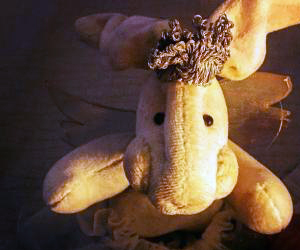 The velvety rabbit with big floppy ears and a silver tiara came to me 34 years ago with a name tag that read, “Fairy God Bunny.” That was when I was in my mid-20s and had cancer. For five years I carried this rabbit with me to the hospital for labs, CT scans and X-rays. I was never shy about introducing it to anyone, nor did I feel hypocritical, even though I was a 26-year-old Ph.D. candidate.
The velvety rabbit with big floppy ears and a silver tiara came to me 34 years ago with a name tag that read, “Fairy God Bunny.” That was when I was in my mid-20s and had cancer. For five years I carried this rabbit with me to the hospital for labs, CT scans and X-rays. I was never shy about introducing it to anyone, nor did I feel hypocritical, even though I was a 26-year-old Ph.D. candidate.
My friend Cynthia had given me the bunny soon after my testicular cancer diagnosis, reminding me several times that it had “magical powers.” She later boosted those powers by adding a wand trimmed in gold lamé to complement its frilly tutu. That bunny was intended to be my talisman, a magical defender against my cancer.
You’d expect me to be skeptical. I’d grown up in an age of science, when facts and data reigned supreme. I’d excelled at Manhattan’s Stuyvesant High School, famous for its geek curriculum. As a three-time visitor to the nearby 1964 World’s Fair, a paean to new technology, I’d drunk DuPont’s Kool-Aid: Better living through chemistry.
When I first got sick, I read every evidence-based, peer-reviewed study I could get my hands on, so I could make the best-informed treatment decisions. My odds of survival were actually pretty decent, but I found that data wasn’t enough. As a twentysomething, I simply couldn’t accept any chance of not making it to 30. Put simply: Science could not guarantee me a 100 percent successful outcome.
Enter the bunny. I needed another tool in my tool belt to improve my chances.
And I was not alone. Stuart Vyse, a psychologist and author of “Believing in Magic: The Psychology of Superstition,” told me that many people turn to “irrational beliefs” in times of dire need. Whenever medical science does not provide a cure, there’s going to be a “psychological gap, the need of something better,” he said. Enter superstition, magic, paranormal beliefs and religion.
“It’s not uncommon to be of two minds and to say, ‘I know this is crazy, but I’ll feel better if I do it anyway,’” Dr. Vyse said.
Indeed, I never abandoned conventional medicine. I followed my oncologist’s orders: Three surgeries. Four rounds of chemo. Years of anxiety-ridden follow-ups. But I would not leave my fate in doctors’ hands alone. The fairy god bunny would be my amulet.
Before knowledge overshadowed faith, talismans and amulets — objects believed to have magical powers — had their place in any self-respecting doctor’s medicine bag. Their documented use dates back at least to the medieval period, when they were an addition to — not replacement for — surgery.
And the use of medical talismans has persisted. Dr. William Bartholome, a pediatrician and bioethicist at Kansas University Medical Center, wrote prolifically about his struggle with metastatic esophageal cancer — and his collection of 40 frogs. “Bill’s frogs were totems or talismans that he believed brought him luck,” said Martha Montello, his friend and a lecturer at the Center for Bioethics at Harvard Medical School. Dr. Montello pointed out that he lived “an amazing five years” after diagnosis, much longer than his doctors predicted. I believe in that kind of magic.